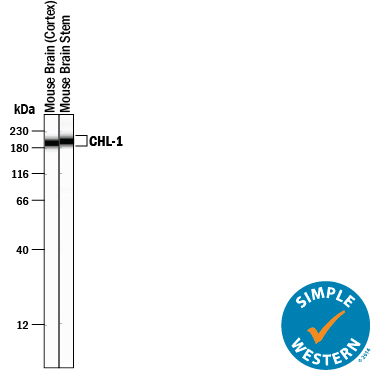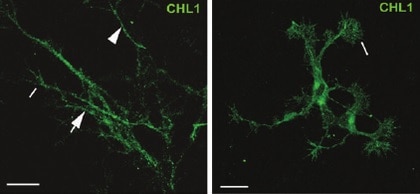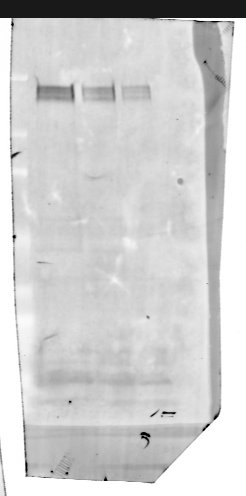Mouse CHL-1/L1CAM-2 Antibody Summary
Ala25-Gln1043 (Leu227-Gln242 del, Ala243Ser)
Accession # BAC30699
Applications
Please Note: Optimal dilutions should be determined by each laboratory for each application. General Protocols are available in the Technical Information section on our website.
Scientific Data
 View Larger
View Larger
Detection of Mouse CHL‑1/L1CAM‑2 by Western Blot. Western blot shows lysates of mouse brain stem tissue. PVDF membrane was probed with 0.25 µg/mL of Goat Anti-Mouse CHL-1/L1CAM-2 Antigen Affinity-purified Polyclonal Antibody (Catalog # AF2147) followed by HRP-conjugated Anti-Goat IgG Secondary Antibody (Catalog # HAF019). A specific band was detected for CHL-1/L1CAM-2 at approximately 200 kDa (as indicated). This experiment was conducted under reducing conditions and using Immunoblot Buffer Group 1.
 View Larger
View Larger
Detection of Mouse CHL‑1/L1CAM‑2 by Simple WesternTM. Simple Western lane view shows lysates of mouse brain (cortex) tissue and mouse brain stem tissue, loaded at 0.2 mg/mL. A specific band was detected for CHL-1/L1CAM-2 at approximately 196-201 kDa (as indicated) using 2.5 µg/mL of Goat Anti-Mouse CHL-1/L1CAM-2 Antigen Affinity-purified Polyclonal Antibody (Catalog # AF2147) followed by 1:50 dilution of HRP-conjugated Anti-Goat IgG Secondary Antibody (Catalog # HAF109). This experiment was conducted under reducing conditions and using the 12-230 kDa separation system.
Reconstitution Calculator
Preparation and Storage
- 12 months from date of receipt, -20 to -70 °C as supplied.
- 1 month, 2 to 8 °C under sterile conditions after reconstitution.
- 6 months, -20 to -70 °C under sterile conditions after reconstitution.
Background: CHL-1/L1CAM-2
Close homolog of L1 (CHL-1), also known as cell adhesion L1-like (CALL) and L1 cell adhesion molecule 2 (L1CAM-2), belongs to the L1 subfamily of immunoglobulin (Ig) superfamily cell adhesion molecules, which also includes L1, neurofascin and NgCAM-related cell adhesion molecule (NrCAM) (1‑3). These molecules are type I transmembrane proteins that have 6 Ig-like domains and 4‑5 fibronectin type III-like (FNIII) domains in their extracellular regions. They also share a highly conserved cytoplasmic region of approximately 110 amino acid (aa) residues containing an ankyrin-binding site. CHL-1 is expressed as a highly glycosylated 185 kDa transmembrane protein by subpopulations of neurons and glia of the central and peripheral nervous system (4, 5). Ectodomain shedding via the metalloprotease-disintegrin ADAM8 releases 165 kDa and 125 kDa soluble CHL-1 fragments, which can diffuse away to function at distant sites (6). CHL-1 is not capable of homotypic interactions, but an extracellular binding partner of CHL-1 has not been identified (4). Human CHL1 has been mapped to chromosome 3p26 and is a candidate gene for 3p- syndrome characterized by mental impairment (7). A missense CHL1 polymorphism associated increased risk of schizophrenia, has also been reported (8). The functional importance of CHL-1 in the nervous system is also evident in CHL-1 deficient mice, which display behavioral abnormalities and show misguided axons within the hippocampus and olfactory tract (9). Enhanced ectodomain-shedding of CHL-1 is also observed in Wobbler mice, the neurodegenerative mutant mice (6). In vitro, soluble or substrate-coated CHL-1 promotes neurite outgrowth and neuronal survival of both cerebellar and hippocampal neurons. Cell surface CHL-1 interacts with integrins in cis to potentiate integrin-dependent cell migration toward extracellular matrix proteins (10). For this enhanced cell motility, CHL-1 linkage to the actin cytoskeleton via interaction between ankyrin and the CHL-1 cytoplasmic region is required.
- Moos, M. et al. (1988) Nature 334:701.
- Holm, J. et al. (1996) Eur. J. Neusci. 8:1613.
- Wei, M. et al. (1998) Hum. Genet. 103:355.
- Hillenbrand, R. et al. (1999) Eur. J. Neurosci. 11:813.
- Liu, Q. et al. (2000) J. Neurosci. 20:7682.
- Naus, S. et al. (2004) J. Biol. Chem. 279:16083.
- Angeloni, D. et al. (1999) Am. J. Med. Genet. 86:482.
- Sakurai, K. et al. (2002) Mol. Psychiatry 7:412.
- Montag-Sallaz, M. et al. (2002) Mol. Cell. Biol. 22:7967.
- Buhusi, M. et al. (2003) J. Biol. Chem. 278(27):25024.
Product Datasheets
Citations for Mouse CHL-1/L1CAM-2 Antibody
R&D Systems personnel manually curate a database that contains references using R&D Systems products. The data collected includes not only links to publications in PubMed, but also provides information about sample types, species, and experimental conditions.
15
Citations: Showing 1 - 10
Filter your results:
Filter by:
-
Reduced secretion of neuronal growth regulator 1 contributes to impaired adipose-neuronal crosstalk in obesity
Authors: E Duregotti, CM Reumiller, U Mayr, M Hasman, LE Schmidt, SA Burnap, K Theofilato, J Barallobre, A Beran, M Grandoch, A Viviano, M Jahangiri, M Mayr
Nature Communications, 2022-11-25;13(1):7269.
Species: Mouse
Sample Types: Tissue Homogenates, Whole Tissue
Applications: IHC, Western Blot -
Proteomic and functional analyses of the periodic membrane skeleton in neurons
Authors: R Zhou, B Han, R Nowak, Y Lu, E Heller, C Xia, AH Chishti, VM Fowler, X Zhuang
Nature Communications, 2022-06-09;13(1):3196.
Species: Mouse
Sample Types: Whole Cells
Applications: ICC -
Spatiotemporal processing of neural cell adhesion molecules 1 and 2 by BACE1 in vivo
Authors: W Kim, H Watanabe, S Lomoio, G Tesco
The Journal of Biological Chemistry, 2021-02-03;0(0):100372.
Species: Mouse
Sample Types: Tissue Homogenates
Applications: Western Blot -
BACE1 partial deletion induces synaptic plasticity deficit in adult mice
Authors: S Lombardo, M Chiacchiar, A Tarr, W Kim, T Cao, G Sigal, TW Rosahl, W Xia, PG Haydon, ME Kennedy, G Tesco
Sci Rep, 2019-12-27;9(1):19877.
Species: Mouse
Sample Types: Tissue Homogenates
Applications: Western Blot -
Axonal growth of midbrain dopamine neurons is modulated by the cell adhesion molecule ALCAM through trans-heterophilic interaction with L1Cam, ChL1 and Semaphorin
Authors: CR Bye, V Rytova, WF Alsanie, CL Parish, LH Thompson
J. Neurosci., 2019-07-12;0(0):.
Species: Mouse
Sample Types: Whole Cells, Whole Tissue
Applications: Cell Culture, IHC -
Close Homolog of L1 Regulates Dendritic Spine Density in the Mouse Cerebral Cortex through Semaphorin 3B
Authors: V Mohan, SD Wade, CS Sullivan, MR Kasten, C Sweetman, R Stewart, Y Truong, M Schachner, PB Manis, PF Maness
J. Neurosci., 2019-06-10;0(0):.
Species: Mouse
Sample Types: Tissue Homogenates, Whole Cells, Whole Tissue
Applications: ICC, IHC, Immunoprecipitation, Western Blot -
BACE1 elevation engendered by GGA3 deletion increases ?-amyloid pathology in association with APP elevation and decreased CHL1 processing in 5XFAD mice
Authors: W Kim, L Ma, S Lomoio, R Willen, S Lombardo, J Dong, PG Haydon, G Tesco
Mol Neurodegener, 2018-02-02;13(1):6.
Species: Mouse
Sample Types: Tissue Homogenates
Applications: Western Blot -
Transcriptome analysis reveals transmembrane targets on transplantable midbrain dopamine progenitors.
Authors: Bye C, Jonsson M, Bjorklund A, Parish C, Thompson L
Proc Natl Acad Sci U S A, 2015-03-09;112(15):E1946-55.
Species: Mouse, Rat
Sample Types: Tissue Homogenates, Whole Tissue
Applications: Flow Cytometry, IHC -
An aberrant sugar modification of BACE1 blocks its lysosomal targeting in Alzheimer's disease.
Authors: Kizuka Y, Kitazume S, Fujinawa R, Saito T, Iwata N, Saido T, Nakano M, Yamaguchi Y, Hashimoto Y, Staufenbiel M, Hatsuta H, Murayama S, Manya H, Endo T, Taniguchi N
EMBO Mol Med, 2015-02-01;7(2):175-89.
Species: Mouse
Sample Types: Tissue Homogenates
Applications: Western Blot -
beta-Site amyloid precursor protein (APP)-cleaving enzyme 1 (BACE1)-deficient mice exhibit a close homolog of L1 (CHL1) loss-of-function phenotype involving axon guidance defects.
Authors: Hitt B, Riordan S, Kukreja L, Eimer W, Rajapaksha T, Vassar R
J Biol Chem, 2012-09-17;287(46):38408-25.
Species: Mouse
Sample Types: Whole Tissue
Applications: IHC-Fr -
Secretome protein enrichment identifies physiological BACE1 protease substrates in neurons.
Authors: Kuhn PH, Koroniak K, Hogl S, Colombo A, Zeitschel U, Willem M, Volbracht C, Schepers U, Imhof A, Hoffmeister A, Haass C, Rossner S, Brase S, Lichtenthaler SF
EMBO J., 2012-06-22;31(14):3157-68.
Species: Mouse
Sample Types: Cell Lysates
Applications: Western Blot -
EphB regulates L1 phosphorylation during retinocollicular mapping.
Mol. Cell. Neurosci., 2012-05-08;50(2):201-10.
Species: Mouse
Sample Types: Cell Lysates
Applications: Immunoprecipitation, Western Blot -
CHL1 negatively regulates the proliferation and neuronal differentiation of neural progenitor cells through activation of the ERK1/2 MAPK pathway.
Authors: Huang X, Zhu LL, Zhao T
Mol. Cell. Neurosci., 2010-10-08;46(1):296-307.
Species: Mouse
Sample Types: Whole Tissue
Applications: IHC-Fr -
Phosphatidylinositol 3-kinase/protein kinase Cdelta activation induces close homolog of adhesion molecule L1 (CHL1) expression in cultured astrocytes.
Authors: Wu J, Wrathall JR, Schachner M
Glia, 2010-02-01;58(3):315-28.
Species: Mouse
Sample Types: Cell Lysates, Whole Cells
Applications: ICC, Neutralization, Western Blot -
CHL1 promotes Sema3A-induced growth cone collapse and neurite elaboration through a motif required for recruitment of ERM proteins to the plasma membrane.
Authors: Schlatter MC, Buhusi M, Wright AG, Maness PF
J. Neurochem., 2007-11-06;104(3):731-44.
Species: Mouse
Sample Types: Whole Cells
Applications: ICC
FAQs
No product specific FAQs exist for this product, however you may
View all Antibody FAQsReviews for Mouse CHL-1/L1CAM-2 Antibody
Average Rating: 5 (Based on 3 Reviews)
Have you used Mouse CHL-1/L1CAM-2 Antibody?
Submit a review and receive an Amazon gift card.
$25/€18/£15/$25CAN/¥75 Yuan/¥2500 Yen for a review with an image
$10/€7/£6/$10 CAD/¥70 Yuan/¥1110 Yen for a review without an image
Filter by:
80, 40 and 20ug of total mouse brain homogenate was separated by SDS-PAGE and transfered to PVDF membrane
Block: 1% BSA, 1% FSG PBS-T 1h RT
Primary: 1:1000, 1% BSA, 1% FSG PBS-T O/N 4oC
Secondary: 1:5000,1% BSA, 1% FSG PBS-T 2h RT
(Secondary - DaG 800, Licor)




